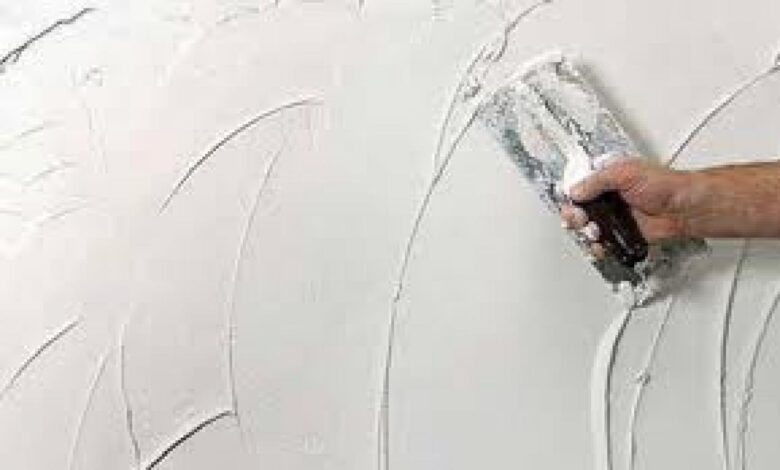Things Need To Be Known About Gypsum Plastering

Gypsum Plastering is perhaps the most well-known completing procedure and is regularly utilized in structures. Plaster was applied to give a smooth surface and a satisfying enhanced visualization, to obstruct the unpleasant surface of the block facades.
Putting further develops excellence as well as goes about as a guard for the blocks from downpour and wind. The mortar materials accessible in the market are concrete mortar, lime mortar, mud mortar, mud mortar, gypsum mortar, and so forth.
As of late, gypsum mortar has become well known and has supplanted lime and concrete mortar. Here, we will talk about the properties, strategy for application, benefits, and disservices of gypsum mortar.
What is Gypsum Plaster?
In Gypsum Plaster, gypsum material is utilized as a folio rather than Portland concrete. Gypsum mortar is a white concrete material made by getting dried out the mineral gypsum.
At the point when dry gypsum powder is blended in with water, it solidifies. This material can be applied over the outer layer of blocks, block,s or cement to shape a smooth surface. The blend is promptly accessible in a prepared-to-utilize design and doesn’t require sand. Just extra water is required. Gypsum mortar offers fantastic acoustic and warm properties as well as gives a level and smooth divider surface.
Gypsum mortar gives a smooth inside finish and is an optimal base for excellent paints and other extra wallcoverings. Gypsum mortar can be applied to smooth and unpleasant divider surfaces.
Gypsum mortar is not difficult to apply and doesn’t need extraordinary laborers, it tends to be worked like conventional concrete mortar. The surface planning and use of gypsum mortar should be fitting to forestall breaking and stripping.
Gypsum Plaster Material Storage
Gypsum surfaces that are presented to dampness can decrease the strength of the gypsum mortar. In this way, the gypsum sack/bundle ought to be put away at a marginally raised put on a dry wooden, block, or substantial plate.
The time span of usability of the gypsum mortar material is generally 3-4 months from the date of production. In the event that appropriately put away under reasonable temperature and dampness conditions, their timeframe of realistic usability can increment by a half year or more.
Gypsum Plaster Thickness
Gypsum Plaster is best made with a thickness of 6 – 20mm. The thickness of the base layer of gypsum mortar is generally 11mm for dividers and 8mm for roofs/roofs, while the last layer of gypsum mortar is normally 2 mm as it were.
It is prescribed to apply a gypsum mortar thickness of no less than 6mm for gypsum mortar so it can abstain from breaking. Assuming that a thickness of in excess of 20 mm of mortar incorporated into the divider is required, then, at that point, the underlying layer of concrete sand mortar is applied with a thickness of 8-12 mm then gypsum mortar for the leftover thickness so it isn’t under 6 mm to accomplish a smooth completion.
Gypsum mortar material specialized particulars
In fact, the gypsum Wall Plaster material is a white-based material with a powder structure. Coming up next is a breakdown of the gypsum mortar specialized details.
- Surface Finish Color: White
- Batter Mixing Time: 25-30 Minutes
- Inclusion Area (12 mm thickness): ~ 1.95 m2/pack
- Bundle Size: 25 kg bundling
- Gypsum mortar is viewed as light and accordingly its utilization for putting doesn’t add to the underlying weight on structures.
- Gypsum mortar doesn’t contract during the drying and solidifying process not at all like concrete mortar.
- Gypsum mortar doesn’t break without any problem.
- Gypsum is non-combustible and contains high translucent water content. In the event of fire, it behaves like an obstruction and safeguards shaft, cement, and steel materials.
- Gypsum can forestall rust on metal utensils, for example, lines and increment its toughness.
- It has low warm conductivity and guarantees energy and power saving.
- Gypsum mortar gives high elastic and bowing strength.
- After the mortar is appropriately applied and dry, it is feasible to color the gypsum mortar with a paint aside from concrete paint.
An overabundance of Gypsum Plaster
- Coming up next are a portion of the benefits you will get on the off chance that you use gypsum mortar:
- The utilization of gypsum mortar is an efficient cycle, bringing about diminished project costs.
- Simple to use for a great completion.
- Gypsum mortar doesn’t need restoring which saves water and time during development.
- Gypsum shows holding properties. Since only one layer is required for the roof, inner block facades, AAC blocks, and substantial segments are adequate.
- The room looks large and delightful in light of the fact that the gypsum mortar is unadulterated white.
- Gypsum mortar is a pre-blended material and comes in simple to-deal with bundles.
- It very well may be effortlessly applied and molded into various shapes for enhancing purposes.
- The working season of the gypsum mortar can be controlled and furthermore the time span expected between two progressive layers is less.
- Gypsum mortar gives a smooth completion to the surface and is prepared to acknowledge practically any paint.
- Different surface surfaces and surface hardness can be acquired.
- Gypsum mortar isn’t impacted by bugs and doesn’t uphold parasitic development.
- Drawbacks of Gypsum Plaster
- Coming up next are a portion of the disadvantages that you will get in the event that you use gypsum mortar:
- For a similar thickness, gypsum mortar is more expensive than concrete mortar. Yet, in regions where waterway sand is difficult to get, gypsum mortar will be financially savvy.
- Gypsum mortar isn’t really great for use on outer dividers since it is powerless to dampness and in regions that are continually sodden like washrooms, latrines, washing regions, kitchens, and so on.




